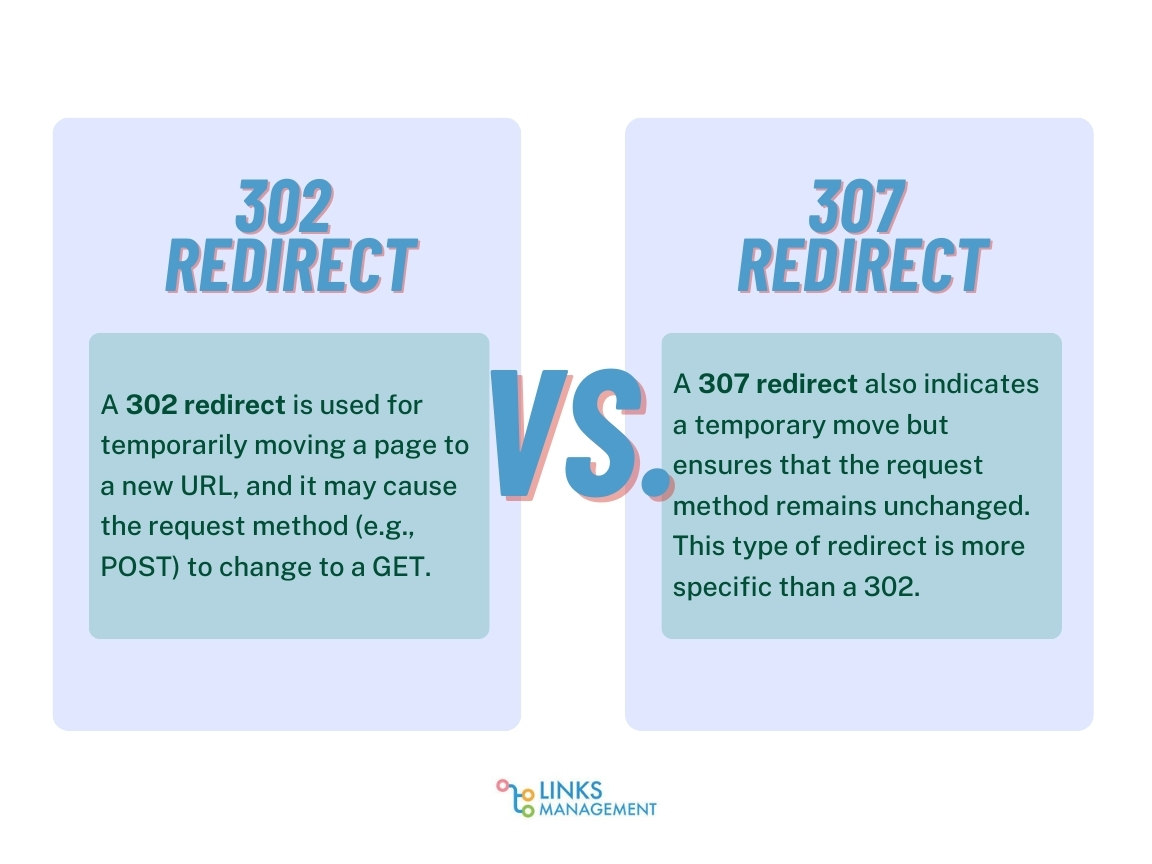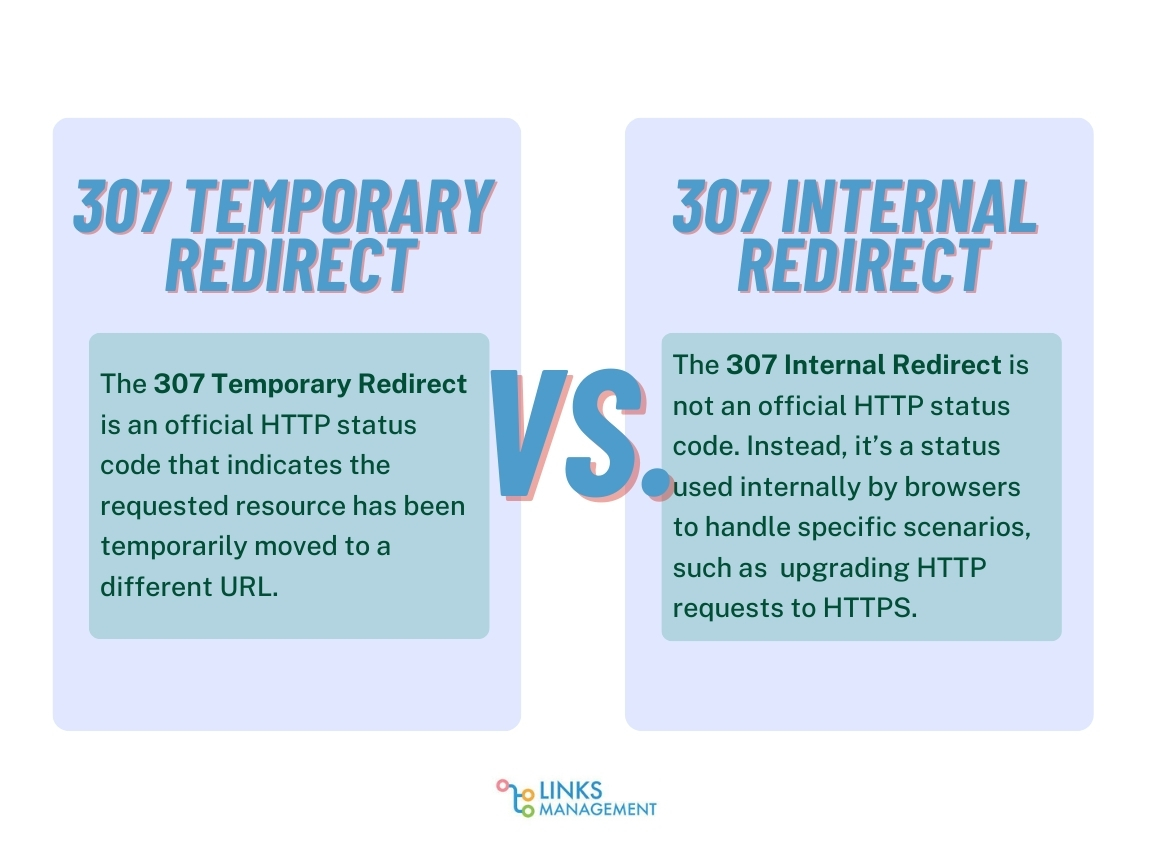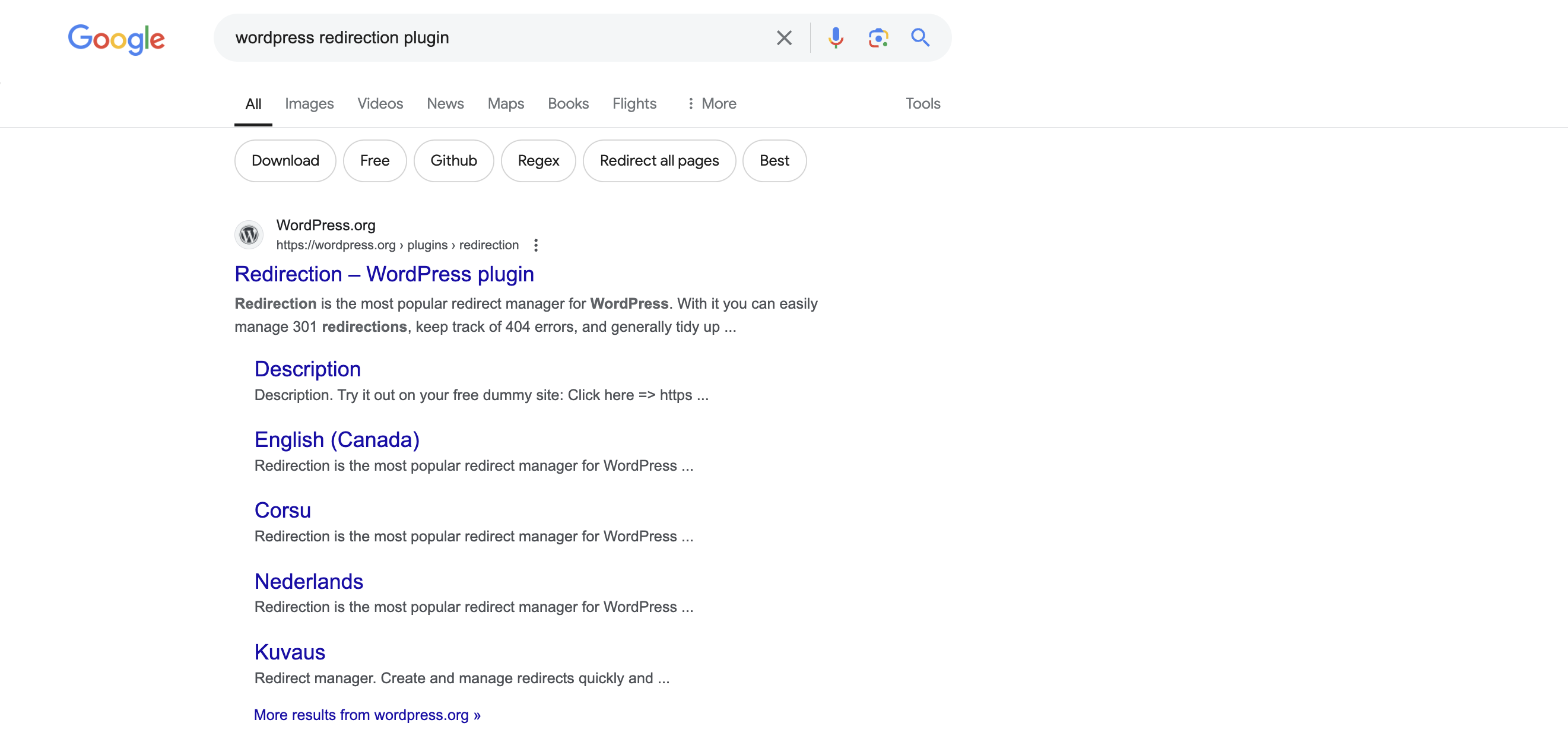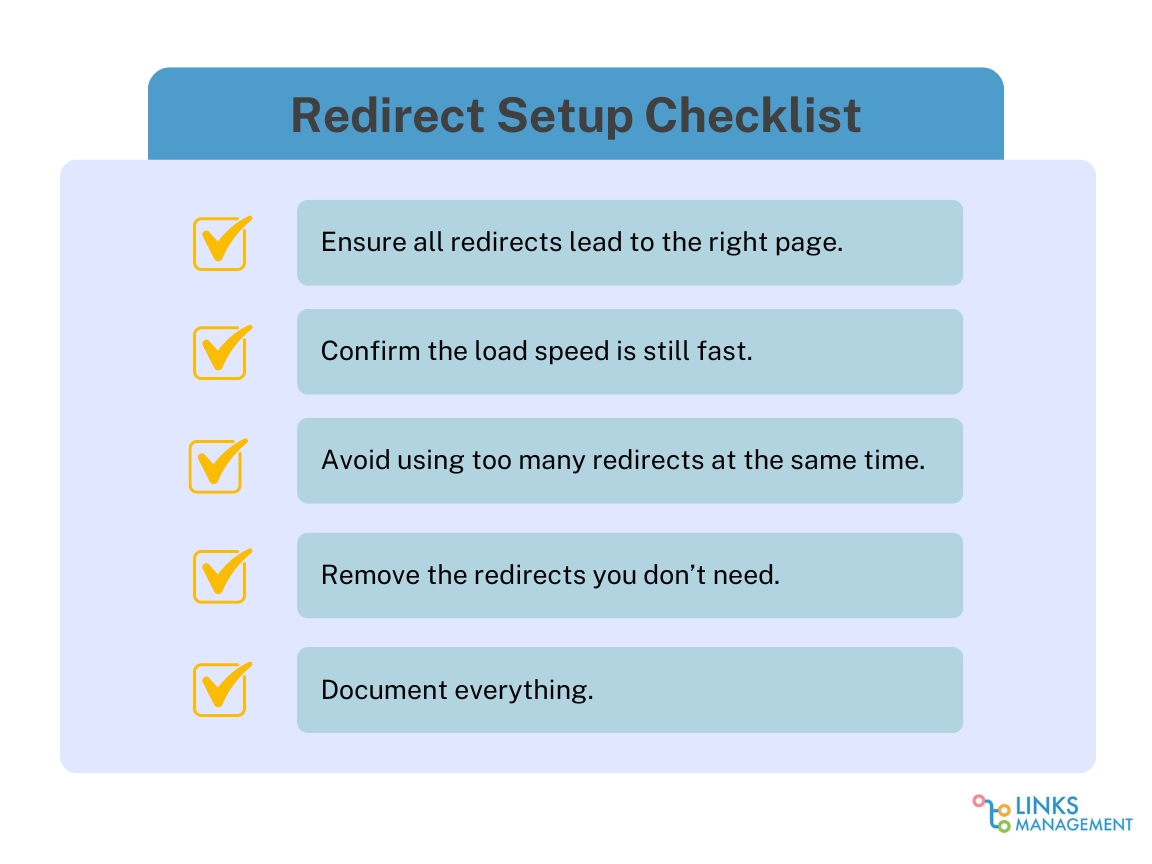307 Redirect in SEO: All Your Questions Answered
To some digital marketers and SEO experts, the idea of a 307 temporary redirect can cause a lot of anxiety.

The wrong use can cause your site to lose its rankings, and you may have to start afresh. But this doesn’t have to be your own story. With just a little guidance, it can be just another routine practice to keep your site in tip-top shape.
So, in this guide, we are tackling all your questions about how it works. In the end, you will have the best hacks to use this redirect effectively like an old pro.
What Is a 307 Redirect?
When people talk about this specific type of redirect, they are referring to an HTTP status code that temporarily reroutes traffic from one webpage to another. Temporarily is the key here.
A 307 basically tells web browsers that the requested URL has been temporarily moved. It has its benefits when used right. But sometimes, when used the wrong way, this can cause issues that affect how users are able to use your site (more on that later).
In terms of 307 redirect SEO, using this redirect doesn’t pass much value as search engines know it’s not permanent.
This is why it doesn’t transfer the link equity to the new page, or if it does, that won’t last long. Still, the original page will continue to be crawled, and its ranking signals will remain preserved.
That’s something you should keep in mind, especially if you are in a niche where it is very hard to build a strong backlink profile and you use paid backlinks.
What’s the Difference Between 3xx Codes?
There are quite a few HTTP status codes, and they all act like a detour for a user’s web traffic. This can get a little confusing, so let’s break down the differences:
- 301 (moved permanently). This means that the requested page has been permanently moved to a new address.
- 302 (found). This one shows that the wanted page now has a new temporary address. Yet, over time, many search engines start treating it like a permanent redirect (aka 301).
- 303 (see other). This one is typically used for form submissions. It prevents users from submitting data more than once by sending them to another page once the form is successfully sent.
- 304 (not modified). This one lets search engines know that there have been no changes since the last time. That’s why they can use the cached version of the requested page.
- 307 (temporary redirect). This is the main hero of this guide – a temporary redirect that alerts you that the requested page has been moved somewhere else for a short time.
302 vs. 307 Redirects

If you’ve been following, you’ll notice that it seems that 302 and 307 redirects look like the same thing. Yes, but in reality, they aren’t the same.
Both 302 and 307 refer to temporary redirects. And both also signal to search engines that the original page will be used in the future. That’s why search engines continue to index that page and preserve its SEO value.
What’s the difference, then?
One of the major ones hides behind how the requests are handled. The common issue occurs when it comes to a POST request (the one that sends data to a server) and a GET request (the one that retrieves data from a server).
While initially, a 302 redirect was meant to preserve each request method, in reality, it doesn’t work like this. More often than not, browsers treat it as a GET request. As a result, a 302 can change a POST request to a GET request, which can return an unexpected result.
This can also expose sensitive data (if any). Plus, some hackers use a 302 redirect to send users from a legitimate site to its malicious version.
Besides, when it comes to SEO, search engines can start treating a 302 redirect as a permanent change (like a 301) if you’re using it for a long time.
On the other hand, the 307 redirects are more reliable and won’t change a POST request to a GET request. As a result, the request form remains unchanged, user information is more secure, and any data submitted gets to the right destination.
When in doubt over the whole 302 vs. 307 redirects, remember that both are fine for some use cases. Yet, you should only use 302 redirects when you don’t care about the request method.
307 Temporary Redirect vs. 307 Internal Redirect

Just when you think you’ve finally figured out the difference between 3xx codes, then comes 307 temporary redirect vs. 307 internal redirect. What’s even more confusing? Sometimes, people use the two to refer to the same thing.
But look at the two a little more closely, and you will find that there is a major difference. Still, let’s first see what each of these means:
- The 307 temporary redirect is an official HTTP status code that tells the web browser that the page the user wants to land on has been moved someplace else for now.
- The 307 internal redirect is not official and happens internally in browsers to send the visitor from the insecure HTTP version of your site to the more secure HTTPS version.
The internal redirect happens on the server side, so it is absolutely unnoticeable for a user. Besides, this redirect doesn’t have any direct effect on your SEO, as it is more about the secure communication between a server and a browser.
When Should You Use 307 Redirects
You may have heard people talk about SEO or site migration and wondered which redirects they need for that, right? Well, here’s the answer you’ve been searching for.
First off, a 307 redirect is a bad choice for a site migration since those kinds of moves are permanent. That being said, there are still multiple great use cases for a 307:
#1 Sending Users From HTTP to HTTPS
This lets you use the HSTS feature that tells your browser to switch over to the secure HTTPS all the time. Even if your visitor, by mistake, uses the insecure HTTP, the browser will quickly send them to the secure HTTPS version of your site.
#2 A/B Testing
Say you are planning to launch a new web page, and you want to try out different versions of it to see which one works best. Then, this redirect is a great option for such a case.
For example, you can try different CTAs, design versions, or pain points in your copy. You can temporarily direct traffic to each version till you gather the data you need and then make the final decision based on that feedback.
The same thing applies if your site runs a lot of temporary/seasonal campaigns like discounts, giveaways, and sweepstakes that change regularly. In such a case, it’s not a bad idea to use a 307 redirect.
#3 Site Maintenance
You can use this option during your routine site maintenance. This way, your visitors won’t get error messages when they try to open the affected pages. Of course, you only need this till the maintenance is done, and after that, you can remove the redirect.
When Using 307 Redirects Isn’t a Good Idea
By now, you can probably think of at least one use case where the 307 just doesn’t fit. Yet, let’s mention some of them either way.
#1 Permanent URL Changes
Since a 307 is designed to be used for only a short time, it’s a bad idea to set it up when you want to move traffic from one webpage to another on a permanent basis.
A better approach would be to use the 301 (move permanently). This way, you also preserve every SEO benefit of the original page.
#2 Bulk Redirects
Some people decide to use the temporary redirect for each page when they are restructuring their entire website. This wastes a lot of time, affects the user experience of your site, and makes your pages load slowly.
Worse, search engines will find it difficult to properly crawl and index your site.
But hey, mistakes can happen. If you have run into some troubles and are wondering how to fix your redirect issues, do the following:
- Check your server configuration to make sure the rules are pointing to the right page.
- Make sure there are no mistakes in the URLs.
- Follow the right process for your CMS platform (check their documentation to be sure).
So, how do you do the whole redirect thing the right way? That brings us to the next section.
3 Common Ways to Set Up a 307 Redirect
The idea of setting up a redirect can be scary, but it doesn’t have to be. The good news is whether you are an expert or a newbie, you can find a way that works for you by starting with any of the following three.
#1 Plugin
There are tons of free plugins for everything these days, so it’s easy to find one for setting up the redirect.
It’s even simpler if you are on a CMS platform like WordPress. Simply search inside the platform (if possible) or google your CMS + the keyword “redirection plugin.”

Once you find one, install it and follow the prompts to set it up and run it in no time.
#2 Via the .htaccess File
Now, not everyone uses a CMS system, and that’s fine. You can edit your .htaccess file and change things from there. The only problem is that this option requires you to know what you are doing; otherwise, you risk damaging your website.
How do you find the .htaccess file? Just check the root directory of your website hosting account. What you want is inside the “public_html” folder.
The RewriteEngine file should say On. If everything checks out, go ahead and add the redirect code “Redirect 307/oldpage.html/newpage.html” at the end of the .htaccess file. Hit save and test to see if everything works as it should.
#3 Code It Yourself
While plugins are great for people with little to no technical knowledge of how this works, some people like to have more control over things.
If you know a bit of JavaScript and PHP, then chances are that you already have the skills to make the change manually.
Yet, be careful, double-check everything, and make sure the code is correct and everything works as it should. This way, you don’t mistakenly break your website.
In the worst-case scenario, you can make your site vulnerable to attacks. As a result, a spammer can use a redirect like this one to route browser traffic to their site or ads like in this case.
We don’t want to scare you. The only thing we want is for you to set up everything correctly without any issues. So, check everything twice. You know how it goes — better safe than sorry.
Bonus: Redirect Setup Checklist

Setting up a redirect isn’t too hard, but you have to know what you’re doing. To help you out a bit, we’ve prepared this checklist for you. Regardless of which method you choose:
- Check to make sure all redirects lead to the right page;
- Even when they do, confirm that your load speed is still fast;
- Avoid using too many redirects at the same time;
- Quickly remove the redirects once there is no need for them;
- Document everything.
Conclusion
When it comes to the 307 temporary redirects, there is a right way to use them that ensures that you preserve all the SEO results that came from years of hard work.
Use a few 307s at a time and only as a short-term measure. Besides, make sure it points users and crawlers to the intended place. Used this way, it won’t hurt your web performance or SEO.
Enter URL & See What We Can Do Submit the form to get a detailed report, based on the comprehensive seo analysis.





